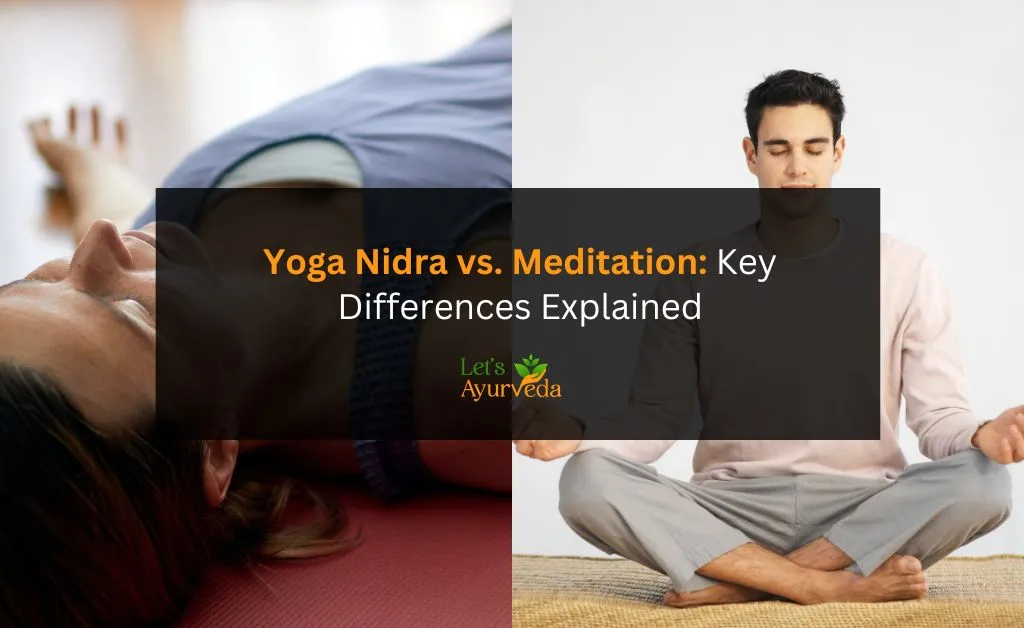Yoga Nidra and meditation are two powerful practices that have been gaining popularity for their transformative effects on the mind and body. But what sets them apart? Which one should you choose for deeper relaxation, improved focus, or heightened awareness? Let’s break it down and uncover how these practices differ, their unique benefits, and how you can integrate them into your life for maximum results.
What Is Yoga Nidra?
Yoga Nidra, often called "yogic sleep," is a guided relaxation technique designed to bring you into a state of deep physical, mental, and emotional rest. While it might look like lying down and listening to a soothing voice, there’s much more happening beneath the surface.
-
How It Works: Yoga Nidra guides you through the layers of consciousness, from wakefulness to deep relaxation, without losing awareness. This process activates the parasympathetic nervous system, which helps your body repair and rejuvenate.
-
The Experience: You typically lie in Savasana (corpse pose) while an instructor leads you through body scans, breath awareness, and visualizations.
What Is Meditation?
Meditation is a broader practice aimed at training the mind to achieve clarity, focus, and emotional balance. It comes in many forms, from mindfulness meditation to transcendental meditation, and can be practiced sitting, walking, or even standing.
-
How It Works: Meditation often involves focusing on a specific object, thought, or sensation to cultivate present-moment awareness.
-
The Experience: Unlike Yoga Nidra, meditation requires active engagement of the mind. You might focus on your breath, repeat a mantra, or observe your thoughts without judgment.
Key Differences Between Yoga Nidra and Meditation
|
Aspect |
Yoga Nidra |
Meditation |
|---|---|---|
|
Purpose |
Deep relaxation and healing |
Mental clarity and awareness |
|
State of Consciousness |
Hovering between sleep and wakefulness |
Fully awake and alert |
|
Posture |
Lying down |
Sitting upright |
|
Effort Level |
Passive |
Active |
|
Technique |
Guided body scans and visualization |
Focus on breath, mantra, or thoughts |
The Science Behind Yoga Nidra and Meditation
Yoga Nidra:
-
Research shows that a 30-minute Yoga Nidra session can be as restorative as 2-4 hours of deep sleep. This is because it promotes the release of tension in the body and mind.
-
A study published in the Journal of Alternative and Complementary Medicine found that Yoga Nidra significantly reduces stress and improves emotional regulation by lowering cortisol levels.
Meditation:
-
Meditation is backed by decades of research. Studies show that 8 weeks of regular meditation practice can increase the size of the prefrontal cortex, the area of the brain responsible for decision-making and emotional control.
-
Meditation also improves focus and reduces anxiety. According to the American Psychological Association, mindfulness meditation reduces symptoms of depression by 20% in just 6 weeks.
Benefits of Yoga Nidra
-
Deep Relaxation: Yoga Nidra allows your body to fully relax, which helps improve sleep quality and reduces insomnia.
-
Stress Reduction: By activating the parasympathetic nervous system, Yoga Nidra calms the "fight or flight" response, leaving you feeling rejuvenated.
-
Healing and Recovery: Athletes and patients recovering from illnesses often use Yoga Nidra to accelerate physical and mental recovery.
-
Emotional Balance: This practice helps you process and release pent-up emotions in a safe, non-invasive way.
Benefits of Meditation
-
Enhanced Focus: Meditation trains your mind to stay in the present, reducing distractions and improving concentration.
-
Mental Clarity: Regular practice declutters your mind, helping you think more clearly and make better decisions.
-
Emotional Stability: Meditation promotes emotional resilience, helping you handle challenges with grace and calmness.
-
Physical Health: Meditation lowers blood pressure, boosts immunity, and reduces chronic pain by rewiring how the brain processes discomfort.
Choosing Between Yoga Nidra and Meditation: Which Is Right for You?
-
If You’re Stressed or Exhausted: Go for Yoga Nidra. It’s easier for beginners and gives you immediate relaxation.
-
If You Want to Improve Focus: Meditation is your best bet. It builds mental stamina and sharpens awareness over time.
-
If You Have Trouble Sleeping: Yoga Nidra’s sleep-inducing qualities make it ideal for insomniacs or anyone struggling with restless nights.
-
If You Want a Daily Mental Reset: Meditation offers quick mental clarity, making it perfect for a mid-day refresh.
How to Practice Yoga Nidra and Meditation at Home
Yoga Nidra:
-
Find a quiet space and lie down on your back.
-
Use a guided recording or app to follow the practice.
-
Focus on the instructor’s voice and let go of your thoughts.
-
Aim for a session of 20-30 minutes.
Meditation:
-
Sit comfortably in a chair or on the floor.
-
Close your eyes and take a few deep breaths.
-
Focus on your breath, a mantra, or a specific sensation.
-
Start with 5-10 minutes and gradually increase the duration.
Combining Yoga Nidra and Meditation for Maximum Benefits
Why choose one when you can have both? Many practitioners alternate between Yoga Nidra and meditation based on their needs:
-
Start your day with meditation to set a focused, positive tone.
-
End your day with Yoga Nidra to release tension and prepare for restful sleep.
Common Myths About Yoga Nidra and Meditation
-
“Yoga Nidra is just sleep.”
-
Not true! While it might feel like sleep, Yoga Nidra keeps your mind consciously aware, promoting deeper relaxation than regular rest.
-
-
“Meditation requires a blank mind.”
-
False. Meditation isn’t about stopping your thoughts; it’s about observing them without attachment.
-
-
“You need to practice for hours to see results.”
-
Consistency matters more than duration. Even 10 minutes a day can make a difference.
-
Final Thoughts
Yoga Nidra and meditation aren’t just practices—they’re tools for transforming your mind and body. While Yoga Nidra focuses on deep relaxation, meditation builds awareness and clarity. Together, they create a holistic approach to mental and physical well-being.
Whether you’re a beginner or a seasoned practitioner, incorporating these practices into your routine can unlock levels of rest and awareness you never thought possible. So, why not give both a try and see what works best for you?






